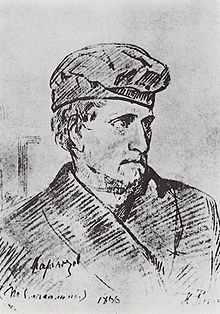- Dmitry Karakozov
-
Dmitry Karakozov 
Portrait of D. V. Karakozov by Ilya Repin (1866)Born October 23, 1840 – November 4, 1840
Kostroma, RussiaDied September 3, 1866 – September 15, 1866
St. Petersburg, RussiaDmitry Vladimirovich Karakozov (Дмитрий Владимирович Каракозов in Russian) (October 23 Old Style (November 4 New Style), 1840 – September 3 Old Style (September 15 New Style), 1866) was the first Russian revolutionary to make an attempt on the life of a tsar.
Karakozov was born in the family of a minor nobleman in Kostroma. He grew to hate his class because all they did was "Suck the peasants' blood." He studied at Kazan University 1861-4 and at Moscow State University 1864-6. He was expelled from both which led to depression and a failed suicide bid. In early 1866, he became a member of the "revolutionary wing" of the Ishutin Society, founded by his cousin Nikolai Ishutin in Moscow in 1863. In the spring of 1866, Karakozov arrived in St.Petersburg to assassinate Alexander II. He circulated his hand-written proclamation called "Друзьям-рабочим" ("To Friends-Workers"), in which he incited people to revolt. He wrote a manifesto to the St Petersburg governor blaming the Tsar for the suffering of the poor: "I have decided to destroy the evil Tsar, and to die for my beloved people."[1] This note never reached anyone, it was lost in the mail.[2] It's possible 1866 was the chosen year because of the character of Rakhmetov in What Is to Be Done?. This fictional inspiration of revolutionary youth plans for a revolution to coincide with the apocalypse according to Newton-1866.[3]
The inner organisation, nicknamed hell, chose him by lots. He was more enthusiastic than the others, many even tried to talk him out of it.
On April 4, 1866, Dmitry Karakozov made an unsuccessful attempt on the life of Tsar Alexander II at the gates of the Summer Garden in St.Petersburg. As the Tsar was leaving, Dmitry rushed forward to fire. The attempt was thwarted by Osip Komissarov, a peasant-born hatter's apprentice, who jostled Karakozov's elbow right before the shot was fired [1]. Contemporary monarchists argued that Komissarov's action proved the people's love for their tsar while contemporary radicals and later Soviet historians argued that Komissarov's involvement in the event was either an accident or an outright government fabrication. Komissarov was ennobled and given a generous stipend, but proved to be an embarrassment to the government due to his boorishness and incoherence and had to be politely removed to the countryside. [2]
Karakozov tried to flee instead of using the second cartridge in his double barreled gun, but was easily caught by the guards. He kept one hand in his jacket. It was revealed later to be holding morphine} and strychnine to kill himself and prussic acid to disfigure his face. Alexander asked:[4]
He was taken to the St Peter and Paul fortress. Dmitry begged for forgiveness and converted to Russian Orthodoxy. The Supreme Criminal Court sentenced him to death by hanging and he was executed in St. Petersburg on September 3, 1866. 10 of his accomplices were exiled to hard labor, the other 25 were acquitted.
As a result of the assassination attempt, the Tsar punished St Petersburg University. Students could no longer form any organisations no matter how harmless (Ishutin's organisation had officially been to set up sewing cooperatives), students were under constant surveillance and periodic searches. Karakozov was an inspiration for the radical nihilists Sergei Nechaev and Vera Zasulich.[5]
Notes
- ^ See, e.g., Adam Bruno Ulam. Prophets and Conspirators in Pre-Revolutionary Russia, New Brunswick, NJ, Transaction Publishers, 1998 (first edition 1977) ISBN 0-7658-0443-3 pp. 3–5.
- ^ For an analysis of the public perception of the assassination attempt and Komissarov's actions, see Richard S. Wortman. Scenarios of Power: Myth and Ceremony in Russian Monarchy: Volume Two: From Alexander II to the Abdication of Nicholas II, Princeton University Press, 2004, ISBN 0-691-02947-4, pp. 110–113
See also: Claudia Verhoeven. The Odd Man Karakozov: Imperial Russia, Modernity and the Birth of Terrorism, Ithaca: Cornell University Press, 2009, ISBN 978-0-8014-4652-8, 248 pp.
References
Categories:- 1840 births
- 1866 deaths
- 1866 crimes
- Narodniks
- Moscow State University alumni
- Russian assassins
- Failed regicides
- Executed Russian people
- People executed by the Russian Empire
- 19th-century executions
- People executed by hanging
- People executed for attempted murder
- People from Kostroma
Wikimedia Foundation. 2010.
